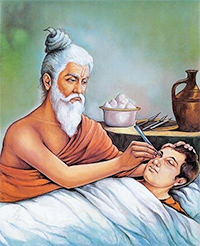 While we associate today’s cosmetic surgical procedures with current-day science and technology, in truth the desire to physically alter the human body cosmetically goes back as far as we can explore into human existence. One only has to look at the centuries-old body modification traditions of tribal societies worldwide, such as the elongation of necks, the insertion of discs into lips and earlobes, etc., to see that body modification is not unique to the modern world.
While we associate today’s cosmetic surgical procedures with current-day science and technology, in truth the desire to physically alter the human body cosmetically goes back as far as we can explore into human existence. One only has to look at the centuries-old body modification traditions of tribal societies worldwide, such as the elongation of necks, the insertion of discs into lips and earlobes, etc., to see that body modification is not unique to the modern world.
Many cultures in history are known to have practiced various surgical and non-surgical forms of body modification techniques and traditions, including the ancient Egyptians, the Mayans and the Incas. In these cultures, the practices were primarily associated with religious traditions. In ancient Rome, cosmetic surgery practices evolved to the matters of vanity or social acceptance. Gladiators with hacked-off ears or noses underwent facial surgeries to mend their appearance, and there are even records of breast reduction procedures being performed.
It is in ancient India, however, that we find what is generally recognized as the birthplace of modern cosmetic surgery. In ancient Sanskrit texts written by Sushruta dating back to 800 B.C., we find reference to a wealth of surgical techniques, including rhinoplasty surgeries that are the origins of today’s procedure. In fact, it is through the dissemination of these texts, as they were first translated into Arabic in 750 A.D., and subsequently moved into Europe, that the Western world was exposed to the first cosmetic surgical procedures.
Rhinoplasty was used in Renaissance Europe by various practitioners, including many barber shops. This time period also saw the first Western text written on the subject – Tagliacozzi’s De Curtorum Chirugiau. Unfortunately this Western application of cosmetic surgical techniques was short-lived due to the social and religious morals of the time, thus the tradition was lost in Europe.
In the 18th century, a British physician witnessed an Indian bricklayer perform a rhinoplasty on a British cattle driver who had his nose removed as punishment in an Indian prison. This sparked an interest within the medical community in Great Britain and caused an influx of surgeons from England to India as they sought to learn the techniques. Surgeons like Joseph Constantine Carpue, who spent 20 years in India studying the time-honored surgical traditions, brought this knowledge and experience back to their home country. By 1815, Carpue had performed the first major cosmetic surgery in the Western world.
